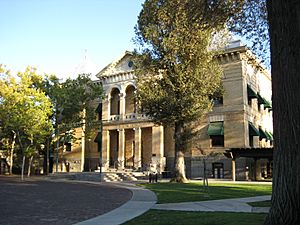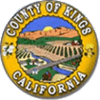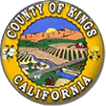Kings County, California facts for kids
Quick facts for kids
Kings County, California
|
|||
|---|---|---|---|
| County of Kings | |||

Kings County Courthouse
|
|||
|
|||

Location in the state of California
|
|||
| Country | United States | ||
| State | California | ||
| Region | San Joaquin Valley | ||
| Metropolitan area | Hanford-Corcoran | ||
| Established | March 22, 1893 | ||
| Named for | Kings River | ||
| County seat | Hanford | ||
| Largest city | Hanford (population) Avenal (area) |
||
| Incorporated cities | 4 | ||
| Government | |||
| • Type | Council–CAO | ||
| • Body | Board of Supervisors | ||
| Area | |||
| • Total | 1,392 sq mi (3,610 km2) | ||
| • Land | 1,389 sq mi (3,600 km2) | ||
| • Water | 2.1 sq mi (5 km2) | ||
| Highest elevation | 3,476 ft (1,059 m) | ||
| Population
(2020)
|
|||
| • Total | 152,486 | ||
| • Density | 109.54/sq mi (42.295/km2) | ||
| GDP | |||
| • Total | $8.146 billion (2022) | ||
| Time zone | UTC−8 (Pacific Time Zone) | ||
| • Summer (DST) | UTC−7 (Pacific Daylight Time) | ||
| Area code | 559 | ||
| FIPS code | 06-031 | ||
| GNIS feature ID | 277280 | ||
| Congressional districts | 20th, 22nd | ||
| Website | countyofkings.com | ||
Kings County is a county in the U.S. state of California. In 2020, about 152,486 people lived there. The main city and government center is Hanford.
Kings County is part of the Hanford-Corcoran, CA metropolitan area. It is also part of the larger Visalia-Porterville-Hanford, CA area. The county is located in the San Joaquin Valley, which is a very important farming area.
Contents
History of Kings County
For thousands of years, Native Americans, like the Tachi Yokuts tribe, lived in this area. Today, their descendants still live on the Santa Rosa Rancheria. Over time, the land was claimed by Spain, then Mexico, and finally the United States.
How Kings County Got Its Name
In 1805, a Spanish expedition likely led by Lieutenant Gabriel Moraga found a river. They named it El Rio de los Santos Reyes, which means "River of the Holy Kings." This name refers to the Three Wise Men from the Bible. When the United States took over California in 1848, they changed the name to Kings River. The county was later named after this river.
Important Events in Kings County
In 1880, there was a serious conflict over land between settlers and the Southern Pacific Railroad. This led to a gun battle on a farm near Hanford, where seven men died. This sad event is known as the Mussel Slough Tragedy.
Kings County was officially created in 1893 from the western part of Tulare County. Later, in 1909, a part of Fresno County was added to Kings County.
Settlers also developed the land around Tulare Lake for farming. This lake was once the largest freshwater lake west of the Great Lakes. It was home to many birds and wildlife. However, farming practices have greatly reduced the natural habitats for these animals.
In 1928, oil was found in the Kettleman Hills in the southwestern part of Kings County. The Kettleman North Dome Oil Field became one of the most productive oil fields in the United States.
During the Great Depression in 1933, many cotton pickers, mostly Mexican workers, went on strike in the San Joaquin Valley. About 3,500 striking farm workers stayed in a camp near Corcoran. The government stepped in to help both sides reach an agreement.
Military Presence and Water Supply
During World War II, Lemoore Army Airfield was built for training. In 1961, the U.S. Navy opened NAS Lemoore, which is a large naval air station near Lemoore.
In the early 1970s, the California Aqueduct was finished. This important project brought much-needed water for farming and homes to the western part of the county.
Historic Sites
Kings County has several interesting historic places:
- Kingston
- Mussel Slough Tragedy
- El Adobe de los Robles Rancho (built by Daniel Rhoads)
- Vaca Adobe
- Cox & Clark Trading Post and Steamboat Landing
- Witt Site
Geography of Kings County
Kings County covers about 1,392 square miles (3,605 square kilometers). Most of this area is land, with a small amount of water.
The county shares its borders with several other counties:
- North and northwest: Fresno County
- East: Tulare County
- South: Kern County and a small part of San Luis Obispo County
- West: Monterey County
The highest point in Kings County is Table Mountain. It is about 3,476 feet (1,059 meters) high and is located in the Diablo Range.
Most of the historic Tulare Lake was located within Kings County. Even though it was drained for farming in the late 1800s, it was once the largest freshwater lake west of the Great Lakes.
Population and People
| Historical population | |||
|---|---|---|---|
| Census | Pop. | %± | |
| 1900 | 9,871 | — | |
| 1910 | 16,230 | 64.4% | |
| 1920 | 22,031 | 35.7% | |
| 1930 | 25,385 | 15.2% | |
| 1940 | 35,168 | 38.5% | |
| 1950 | 46,768 | 33.0% | |
| 1960 | 49,954 | 6.8% | |
| 1970 | 64,610 | 29.3% | |
| 1980 | 73,738 | 14.1% | |
| 1990 | 101,469 | 37.6% | |
| 2000 | 129,461 | 27.6% | |
| 2010 | 152,982 | 18.2% | |
| 2020 | 152,486 | −0.3% | |
| 2023 (est.) | 152,682 | −0.2% | |
| U.S. Decennial Census 1790–1960 1900–1990 1990–2000 2010 2020 |
|||
Population in 2020
According to the 2020 United States Census, Kings County had a population of 152,486 people.
The population includes people from many different backgrounds:
- About 29% were White (not Hispanic).
- About 5.4% were Black or African American (not Hispanic).
- About 1.1% were Native American or Alaska Native (not Hispanic).
- About 3.6% were Asian (not Hispanic).
- About 0.2% were Pacific Islander (not Hispanic).
- About 3.3% were from two or more races (not Hispanic).
- A large group, about 56.8%, were Hispanic or Latino (of any race).
In 2010, the median age in the county was 31.1 years old. The county has a higher number of males compared to females, partly because there are three state prisons for men located there.
Economy of Kings County
The economy of Kings County is mostly based on agriculture. About 87% of the county's land is used for farming. In 2018, the value of all farm products grown in Kings County was over $2.3 billion. This makes Kings County one of the top 10 counties in California for farming.
Main Industries
The most valuable farm product in 2018 was milk, worth about $676.7 million. Other important farm products include pistachios, cotton, cattle, almonds, and tomatoes.
Another very important employer in the county is NAS Lemoore. This is the U.S. Navy's newest and largest base for jet aircraft. In 2008, the base's payroll and spending brought over $1 billion into the local economy each year.
Other major employers in Kings County include:
- Del Monte Foods (a tomato processing plant)
- Adventist Health (a healthcare provider)
- J. G. Boswell Company (a large farming company)
- Olam International (another tomato processing facility)
- Leprino Foods (the world's largest maker of mozzarella cheese)
- The Kings County Government
- The California Department of Corrections and Rehabilitation, which runs three state prisons in the county.
Income and Employment
From 2011 to 2013, the average household income in Kings County was about $47,035. About 17.6% of the people lived below the poverty line.
Kings County was affected by the Great Recession. The unemployment rate went up during that time. However, it had dropped to 9.8% by February 2020, just before the COVID-19 pandemic. In April 2020, it rose again to 16.8%. Many people in Kings County work in services, government, and agriculture.
The dairy industry in Kings County has seen its ups and downs. For example, the value of milk sold dropped significantly in 2009 but then increased again by 2014.
Culture
Kings County has a big yearly event in May called Kings County Homecoming Week. In 2015, it was changed to a one-day event called Pioneer Days. But in 2016, it returned as Kings County Homecoming Week, though without the traditional parade.
Transportation
Major Highways
Several important highways pass through Kings County:
 Interstate 5
Interstate 5 State Route 33
State Route 33 State Route 41
State Route 41 State Route 43
State Route 43 State Route 137
State Route 137 State Route 198
State Route 198 State Route 269
State Route 269
Public Transportation
Kings Area Regional Transit (KART) provides bus services throughout Kings County and to Fresno.
Amtrak trains also stop in Corcoran and Hanford.
Orange Belt Stages offers bus service to and from Hanford. You can connect to Greyhound buses in Visalia or Paso Robles.
Airports
The Hanford Municipal Airport is a general aviation airport located near Hanford. There is also a private airport in Avenal, which is home to the Central California Soaring Club.
Communities
Cities in Kings County
Census-Designated Places (CDPs)
These are areas that are like towns but are not officially incorporated as cities.
- Armona
- Grangeville
- Hardwick
- Home Garden
- Kettleman City
- Lemoore Station
- Stratford
Other Communities
Native American Reservation
Largest Communities by Population (2010 Census)
This table shows the largest communities in Kings County based on the 2010 census. † county seat
| Rank | City/Town/etc. | Type | Population (2010 Census) |
|---|---|---|---|
| 1 | † Hanford | City | 53,967 |
| 2 | Corcoran | City | 24,813 |
| 3 | Lemoore | City | 24,531 |
| 4 | Avenal | City | 15,505 |
| 5 | Lemoore Station | CDP | 7,438 |
| 6 | Armona | CDP | 4,156 |
| 7 | Home Garden | CDP | 1,761 |
| 8 | Kettleman City | CDP | 1,439 |
| 9 | Stratford | CDP | 1,277 |
| 10 | Santa Rosa Rancheria | AIAN | 652 |
| 11 | Grangeville | CDP | 469 |
| 12 | Hardwick | CDP | 138 |
Images for kids
See also
 In Spanish: Condado de Kings (California) para niños
In Spanish: Condado de Kings (California) para niños







